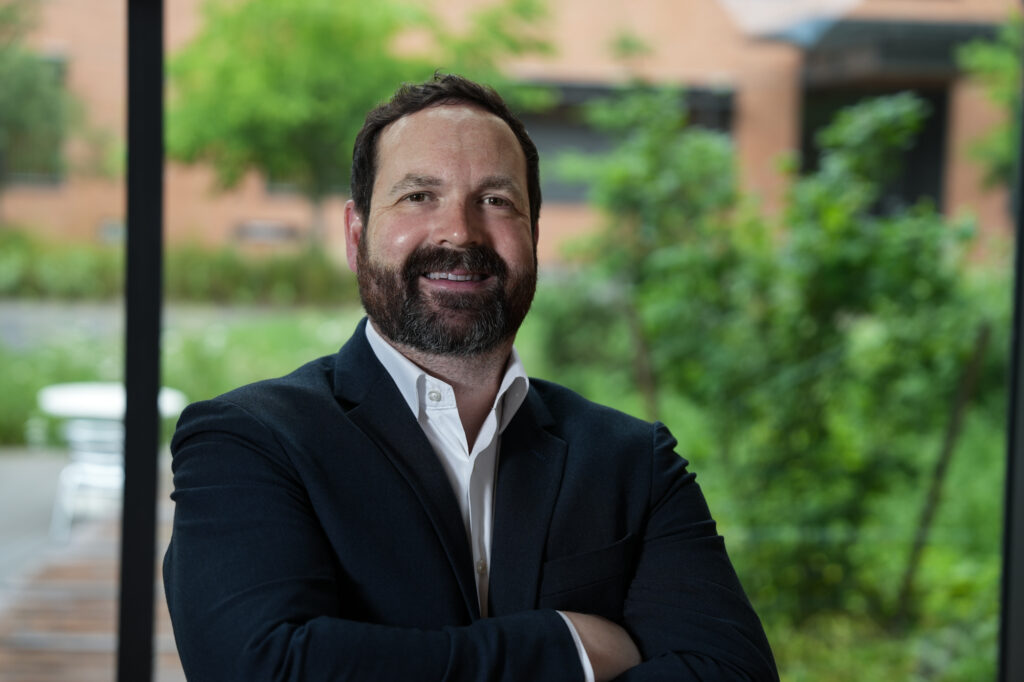
Master of Science in Business Analytics Students Calculate Climate Risk
Students partner with Phillip Bruner at UW Climate Risk Lab to weigh climate risk for Eastern Washington data centers
Will the increasing risk of wildfire due to climate change jeopardize the future viability of hyperscale data centers in Eastern Washington? That’s a question that a team of Foster School of Business Master of Science in Business Analytics (MSBA) students set out to answer at the UW Climate Risk Lab under the leadership of Professor Phillip Bruner. Calculating climate risk was the focus of their capstone project, completed just one week before graduation.
A sustainable finance expert with a background in open-source software, Bruner founded the UW Climate Risk Lab to ensure that data on climate-related financial risks is available to everyone. He also teaches climate risk in the classroom at the Foster School of Business.
At the UW Climate Risk Lab, Bruner is building an open-access data platform to offer standardized and usable climate risk data and modeling tools to nonprofit organizations and government end-users at no cost. The student team— Sarah R. Fauska (MSBA 2024); Skyler R. Ruff (MSBA 2024); Hezekiah M. Shanu (MSBA 2024); and Aartdina P. van den Hoek (MSBA 2024)—set out to use publicly available data to inform public utilities about the knock-on effects of increasing wildfires, including the risk to data centers.
For the MSBA team, it was an opportunity to enhance their skills in research, stakeholder engagement, risk evaluation, and data analytics, while taking a deep dive into the intricacies of calculating climate risk. For Bruner and the UW Climate Risk Lab, it was an opportunity to provide access to climate risk data that could ultimately inform planning by public utilities and local governments—at no cost.
Calculating climate risk for Eastern Washington’s data centers
Let’s take a step back and look at the problem. The team set out to calculate the risk to public utilities—and the downstream effects on the supply chain—due to the increasing frequency of wildfires in Eastern Washington. Wildfires have increased in frequency and severity in recent years due to climate change, putting the power grid at greater risk of curtailments and outages.
On the supply chain side is the growing number of data centers in Eastern Washington that depend on public utilities. Data centers, which provide web hosting, artificial intelligence (AI), and cloud computing for almost all aspects of daily life, can’t operate without a reliable, consistent power supply. Ultimately, the knock-on effects of climate change on data centers could range from severe service disruptions to a total lack of viability in their current locations.

An ever-increasing demand for power
A massive proportion of today’s data, especially sensitive and valuable data, is housed in physical data centers. Historically, companies owned their own data centers and relied on a small amount of power. Today, the industry is almost entirely dominated by hyperscale facilities housing numerous stakeholders’ data that require an ever-increasing power supply to meet the demands of cloud computing and generative AI.
Due to the explosion of data center facilities in the Pacific Northwest, electricity demand is expected to grow 30% in the next decade. Utility companies must prepare to adjust supply planning to meet this increased demand.
According to the U.S. Department of Energy Office of Energy Efficiency & Renewable Energy, data centers are one of the most energy-intensive building types, consuming 10 to 50 times the energy per floor space of a typical commercial office building. These spaces account for approximately 2% of the total U.S. electricity use.[1]
Data centers face escalating risks
With Bruner’s guidance, Ruff, van den Hoek, Fauska, and Shanu focused on more than calculating the risk. They set out to highlight the need for preventive measures and risk mitigation strategies for public utilities.
Their project emphasized the importance of a dependable power supply to meet the growing demand driven by the expansion of data centers, especially given the popularity of cryptocurrency and the rise of generative AI. Using data from Chelan County, the team demonstrated why stakeholders should take preventive actions now to fortify existing facilities and strategically select new locations to minimize wildfire disruptions.
The project resulted in recommendations to ensure that Washington can capitalize on the economic benefits of data center expansion while addressing the significant threats posed by more extreme weather. Their findings underscore the critical need for strategic actions to protect utility infrastructure and ensure the stability of data center operations amid growing climate-related hazards.

Evaluating short- and long-term impacts of wildfires
Wildfires have historically posed a significant risk to public utilities in Eastern Washington. The team’s analysis revealed that increasing wildfire frequency and intensity threatens power infrastructure and supply. Surprisingly, they also found that areas with historically low wildfire risk, such as Western Washington, will also see increased wildfire threats this year. What does this mean for electricity producers and providers? The short answer is increased risk, increased responsibility, and increased cost.
The economic costs of wildfires are substantial, with federal spending on wildfire suppression averaging $2.5 billion annually between 2016 and 2020 (Campbell, 2022). This spending includes direct firefighting and indirect costs such as health care for smoke-related illnesses and loss of revenue from federal timber sales. But calculating climate risk’s true cost is a more complex challenge. The adverse impacts of wildfires extend beyond immediate firefighting efforts, affecting health care, agriculture, and military operations
For the MSBA team, conducting this research within the explosion of generative AI and the continued transition to cloud computing added an additional layer of risk. As more companies adopt new AI solutions, energy demands will increase, and public utilities will continue to face challenges in meeting this substantial energy demand.
Climate risk is a threat to the supply chain
The team presented a clear message: The increasing risk of wildfires threatens the power supply across Eastern Washington, threatening the entire supply chain that depends on the power grid, including the growing data center industry. Data centers can’t operate without a reliable and consistent power supply, and their customers may face disruptions unless action is taken to safeguard utility infrastructure.
Watch their presentation below and read the full report here.
Methodology
From a data perspective, the MSBA team made a concerted effort to use publicly available data from sources such as the Washington Department of Natural Resources, the U.S. Energy Information Administration, FEMA, the EPA, and an Overpass API query from the UW Climate Risk Lab to create an interactive data story on Tableau. To identify high-risk areas, they analyzed wildfire trends, including frequency and geographic spread in regions across Eastern Washington. Additionally, they assessed how wildfires impact power supply infrastructure and evaluated the vulnerability of data centers to power outages.
Digging into climate risk data
The MSBA students reported that participating in the capstone project enhanced their research, stakeholder engagement, risk evaluation, and data analytics skills. The team built a Vector Autoregression (VAR) model to analyze and quantify the relationship between wildfire damage in each region over time to generate predictions for how many acres would burn in each locality. They also created an interactive data story on Tableau, which refined their data analytics and visual storytelling skills. The students shared that this project helped them gain both data-driven decision-making and risk management skills.
Sharing learnings beyond the Climate Risk Lab
The student team concluded the project by sharing their findings with stakeholders in the business and energy sectors, including Puget Sound Energy, which supplies electricity and natural gas to a service area with more than 4 million residents in Western Washington; Snohomish County PUD, which provides electricity and water to Snohomish County and Camano Island; the Coalition for Community Solar Access (CCSA), a national trade association representing more than 100 community solar companies, businesses, and nonprofits; and the Amazon Climate Risk team. Read the full report here.
Learn more about Professor Phillip Bruner and the UW Climate Risk Lab here.
[1] Source: www.energy.gov/eere/buildings/data-centers-and-servers
